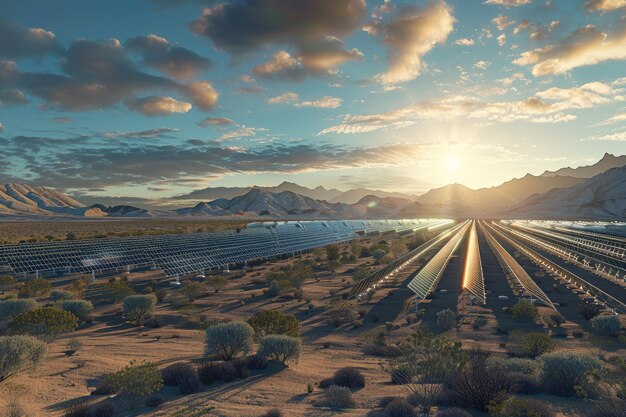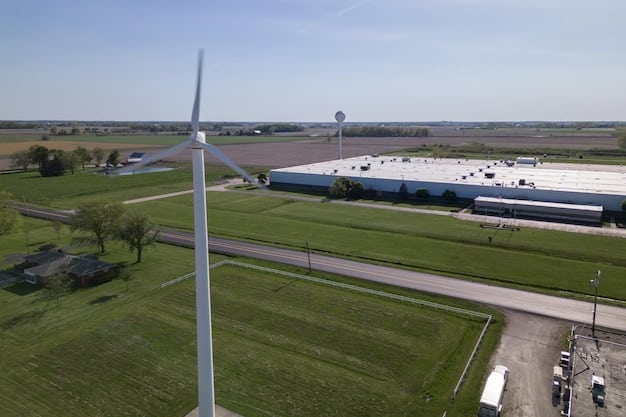Latest Renewable Energy Tech & US Sustainability Goals

What are the Latest Innovations in Renewable Energy Technology and Their Impact on US Sustainability Goals? Recent advancements include enhanced solar panels, advanced battery storage, and smart grids. These innovations significantly contribute to achieving US sustainability goals by reducing carbon emissions and fostering energy independence.
The quest for sustainable energy solutions is more critical than ever in addressing climate change and securing a stable future. As the United States strives to meet ambitious sustainability goals, understanding what are the latest innovations in renewable energy technology and their impact on US sustainability goals becomes paramount. These advancements are not just about generating cleaner energy; they represent a fundamental shift in how we power our lives and protect our planet.
This article delves into the transformative technologies reshaping the renewable energy landscape and their profound effects on achieving US sustainability objectives. Join us as we explore the cutting-edge developments driving this revolution.
Exploring Solar Energy Innovations
Solar energy has become a cornerstone of renewable energy, and ongoing innovations are continually enhancing its accessibility and efficiency. What are the Latest Innovations in Renewable Energy Technology and Their Impact on US Sustainability Goals? From advancements in photovoltaic (PV) cells to improved energy storage solutions, the sector is rapidly evolving to meet the growing demand for clean energy.
Advancements in Photovoltaic (PV) Technology
Photovoltaic technology has seen significant breakthroughs in recent years. The development of new materials and designs has led to more efficient and cost-effective solar panels.
- Perovskite Solar Cells: These cells offer the potential for higher efficiency and lower production costs compared to traditional silicon-based panels.
- Bifacial Solar Panels: These panels capture sunlight from both sides, increasing energy generation by up to 30%.
- Transparent Solar Panels: Integrated into windows and other surfaces, these panels can generate electricity without obstructing light.

These advancements are making solar energy more versatile and practical for a wide range of applications. As PV technology continues to improve, it will play an increasingly important role in meeting US sustainability goals.
Wind Energy: Beyond Traditional Turbines
Wind energy is another crucial component of the renewable energy mix. While traditional wind turbines have been around for decades, new innovations are expanding the possibilities of wind power generation.
High-Altitude Wind Power
High-altitude wind power is an emerging technology that can harness stronger and more consistent winds at higher altitudes, offering a significant boost in energy production.
New technologies like airborne wind turbines and tethered drones are being developed to tap into these resources.
Offshore Wind Farms
Offshore wind farms are becoming increasingly common, leveraging stronger and more consistent winds available over the ocean. These farms can generate substantial amounts of electricity, contributing significantly to US renewable energy targets.
- Floating Wind Turbines: These turbines can be deployed in deeper waters, opening up new areas for offshore wind development.
- Larger Turbine Designs: The development of larger turbines increases energy capture and reduces the cost per kilowatt-hour.
- Advanced Grid Integration: Improved technologies for transmitting offshore wind power to the mainland are essential for efficient energy distribution.
Wind energy is expanding its reach and efficiency, making it a vital contributor to US sustainability efforts. These innovations are pushing the boundaries of what’s possible with wind power, enhancing its role in our energy future.
Energy Storage Solutions: Addressing Intermittency Challenges
One of the main challenges with renewable energy sources like solar and wind is their intermittency. Energy storage solutions are critical for ensuring a reliable and consistent power supply.
Advanced Battery Technologies
Advanced battery technologies are essential for storing excess energy generated during peak production periods, making it available when demand is high.
- Lithium-Ion Batteries: These batteries are widely used in electric vehicles and grid-scale storage due to their high energy density and long lifespan.
- Flow Batteries: These batteries offer long-duration storage and are ideal for grid stabilization.
- Solid-State Batteries: Promising higher energy density and improved safety, solid-state batteries are being developed for both electric vehicles and grid storage.
These technologies are helping to balance the grid and ensure a reliable supply of renewable energy. Advancements in battery technology are crucial for overcoming the intermittent nature of renewable power sources.
Pumped Hydro Storage
Pumped hydro storage involves pumping water uphill to a reservoir during periods of low demand and releasing it to generate electricity when demand increases. This method provides large-scale energy storage and grid stabilization.
Energy storage solutions are pivotal in addressing the intermittency challenges associated with renewable energy sources. The development and deployment of these technologies are crucial for a stable and sustainable energy future.

Smart Grids: Optimizing Energy Distribution
Smart grids are revolutionizing how energy is distributed and managed. By incorporating advanced technologies, these grids enhance efficiency, reliability, and resilience.
Advanced Metering Infrastructure (AMI)
Advanced Metering Infrastructure (AMI) involves the use of smart meters that provide real-time data on energy consumption, enabling better management and optimization of energy resources.
Smart grids are helping to enhance energy efficiency and reduce waste.
Demand Response Programs
Demand response programs incentivize consumers to adjust their energy usage during peak demand periods, reducing strain on the grid and preventing blackouts. These programs play a vital role in balancing energy supply and demand.
Smart grids are an essential component of a modern, sustainable energy system. By optimizing energy distribution and enabling better resource management, smart grids contribute significantly to US sustainability goals.
Geothermal and Hydropower Innovations: Harnessing Earth’s Power
Geothermal and hydropower are established renewable energy sources that are continuing to evolve through technological innovation. The integration of What are the Latest Innovations in Renewable Energy Technology and Their Impact on US Sustainability Goals? is crucial for maximizing their potential and contributing to US sustainability efforts.
Enhanced Geothermal Systems (EGS)
Enhanced Geothermal Systems (EGS) involve creating artificial geothermal reservoirs by fracturing hot, dry rocks deep underground. This technology expands the availability of geothermal energy to regions without natural hydrothermal resources.
Advanced Hydropower Technologies
Advanced hydropower technologies are focused on improving the efficiency and environmental impact of hydropower generation. These include:
- Fish-Friendly Turbines: These turbines are designed to minimize harm to aquatic life, reducing the environmental impact of hydropower dams.
- Small-Scale Hydropower: Utilizing smaller streams and rivers, these systems provide distributed power generation with minimal environmental disruption.
- Pumped Storage Integration: Combining pumped hydro storage with existing hydropower facilities can enhance grid stability and energy storage capacity.
Geothermal and hydropower are critical components of a diversified renewable energy portfolio. Ongoing innovations in these sectors are helping to maximize their potential and minimize their environmental impact.
| Key Aspect | Brief Description |
|---|---|
| ☀️ Solar Innovations | Perovskite cells & bifacial panels boost solar efficiency. |
| 💨 Wind Advancements | High-altitude & offshore wind farms tap into stronger resources. |
| 🔋 Storage Solutions | Advanced batteries and pumped hydro balance power supply. |
| 🌐 Smart Grids | AMI & demand response optimize energy distribution. |
Frequently Asked Questions
Recent innovations include advanced solar panels, high-capacity batteries, smart grids, and Enhanced Geothermal Systems. These advancements are crucial for meeting US sustainability goals by reducing reliance on fossil fuels.
Advanced batteries store excess renewable energy, ensuring a consistent power supply even when solar and wind resources are intermittent. They help balance the grid and reduce reliance on fossil fuels.
Smart grids use advanced technologies like AMI and demand response programs to optimize energy distribution, reduce waste, and enhance grid reliability. This optimizes What are the Latest Innovations in Renewable Energy Technology and Their Impact on US Sustainability Goals?
Offshore wind farms tap into stronger and more consistent winds over the ocean, generating substantial amounts of electricity. This enhances renewable energy production and reduces carbon emissions.
Geothermal energy provides a stable and continuous source of clean energy. Enhanced Geothermal Systems (EGS) expand its availability, contributing to US sustainability goals by reducing reliance on fossil fuels.
Conclusion
The latest innovations in renewable energy technology represent a significant leap towards achieving US sustainability goals. From enhanced solar panels and wind turbines to advanced energy storage and smart grids, these advancements are revolutionizing the energy sector and creating a cleaner, more sustainable future.
By continuing to invest in and deploy these technologies, the United States can significantly reduce its carbon footprint, enhance energy security, and lead the way in the global transition to a green economy, showing the true impact of what are the latest innovations in renewable energy technology and their impact on US sustainability goals.





